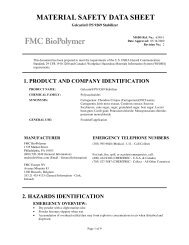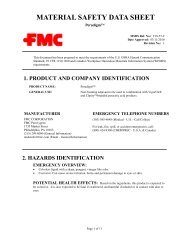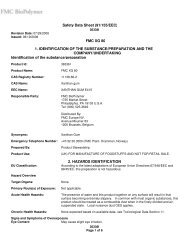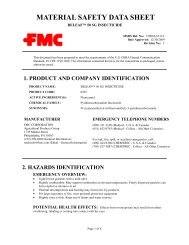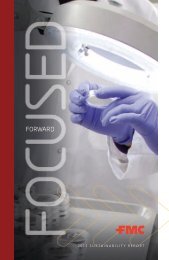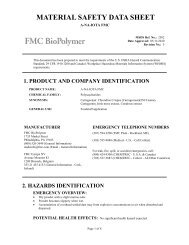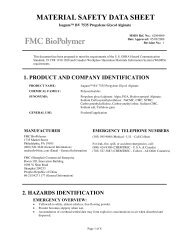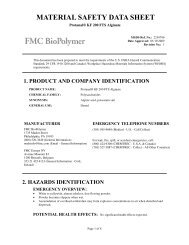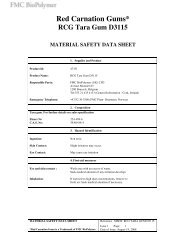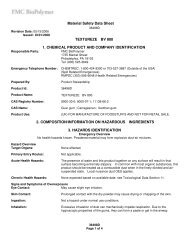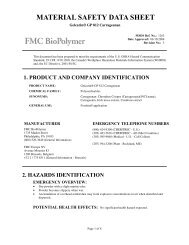Oxygen BioChem (OBC)® - FMC Corporation
Oxygen BioChem (OBC)® - FMC Corporation
Oxygen BioChem (OBC)® - FMC Corporation
Create successful ePaper yourself
Turn your PDF publications into a flip-book with our unique Google optimized e-Paper software.
MATERIAL SAFETY DATA SHEET<br />
<strong>Oxygen</strong> <strong>BioChem</strong> (<strong>OBC</strong>)<strong>®</strong><br />
Page 1 of 10<br />
MSDS Ref. No.: F18-44-8<br />
Date Approved: 04/30/2006<br />
Revision No.: 2<br />
This document has been prepared to meet the requirements of the U.S. OSHA Hazard Communication<br />
Standard, 29 CFR 1910.1200; the Canada’s Workplace Hazardous Materials Information System (WHMIS)<br />
and, the EC Directive, 2001/58/EC.<br />
1. PRODUCT AND COMPANY IDENTIFICATION<br />
PRODUCT NAME: <strong>Oxygen</strong> <strong>BioChem</strong> (<strong>OBC</strong>)<strong>®</strong><br />
GENERAL USE: For chemical oxidation and aerobic bioremediation, petroleum<br />
hydrocarbon remediation, creosote remediation and partially<br />
halogenated hydrocarbon remediation.<br />
MANUFACTURER<br />
<strong>FMC</strong> CORPORATION<br />
<strong>FMC</strong> Peroxygens<br />
1735 Market Street<br />
Philadelphia, PA 19103<br />
(215) 299-6000 (General Information)<br />
2. HAZARDS IDENTIFICATION<br />
EMERGENCY TELEPHONE NUMBERS<br />
(303) 595-9048 (Medical - U.S. - Call Collect)<br />
For leak, fire, spill, or accident emergencies, call:<br />
(800) 424-9300 (CHEMTREC - U.S.A. & Canada)<br />
EMERGENCY OVERVIEW:<br />
• Odorless, off-white fine granular solid (may have separation or noticeable two-tone appearance).<br />
• Oxidizer.<br />
• Contact with combustibles may cause fire.<br />
• Decomposes in storage under conditions of moisture (water/water vapor) and/or excessive heat causing<br />
release of oxides of sulfur and oxygen that supports combustion. Decomposition could form a high<br />
temperature melt. See Section 10 ("Stability and Reactivity").<br />
• Deluge container with water at safe distance or in protected area.<br />
• May be severely irritating to the eyes.<br />
POTENTIAL HEALTH EFFECTS: Airborne dust may be irritating to eyes, nose, lungs,<br />
throat and skin upon contact. Exposure to high levels of dust may cause difficulty in breathing in sensitive<br />
persons. No significant long term inhalation hazard; irritation usually subsides after exposure ceases.
<strong>Oxygen</strong> <strong>BioChem</strong> (<strong>OBC</strong>)<strong>®</strong> (F18-44-8) Date: 04/30/2006<br />
3. COMPOSITION / INFORMATION ON INGREDIENTS<br />
Chemical Name CAS# Wt.% EC No. EC Class<br />
Proprietary Mixture None Not classified<br />
4. FIRST AID MEASURES<br />
EYES: Immediately flush with water for at least 15 minutes, lifting the upper and lower eyelids<br />
intermittently. See a medical doctor or ophthalmologist immediately.<br />
SKIN: Wash with plenty of soap and water. Get medical attention if irritation occurs and persists.<br />
INGESTION: Rinse mouth with water. Dilute by giving 1 or 2 glasses of water. Do not induce<br />
vomiting. Never give anything by mouth to an unconscious person. See a medical doctor immediately.<br />
INHALATION: Remove to fresh air. If breathing difficulty or discomfort occurs and persists, obtain<br />
medical attention.<br />
NOTES TO MEDICAL DOCTOR: Modest irritation is the only expected effect. No<br />
serious consequences are expected, except perhaps in the case of direct eye contact. Contaminated external<br />
surfaces should be flooded with water, and direct eye contact deserves ophthalmologic evaluation. If<br />
ingested, gastrointestinal irritation but not caustic burns are to be expected; dilution with water indicated as<br />
may be gastric evacuation via emesis or lavage if large doses or severe irritation is evident. Demulcents<br />
should be helpful. No systemic effects are expected though human toxicity data is sparse.<br />
5. FIRE FIGHTING MEASURES<br />
EXTINGUISHING MEDIA: Deluge with plenty of water.<br />
FIRE / EXPLOSION HAZARDS: Product is non-combustible. Under fire conditions, may<br />
decompose and release oxygen gas, which may intensify fire. Presence of water accelerates decomposition.<br />
Mixtures with polysulfide polymers may ignite.<br />
FIRE FIGHTING PROCEDURES: Use flooding quantities of water. Use water spray to<br />
keep fire exposed containers cool. Do not use carbon dioxide or other gas filled fire extinguishers; they<br />
will have no effect on decomposition. Wear full protective clothing and self-contained breathing apparatus.<br />
Page 2 of 10
<strong>Oxygen</strong> <strong>BioChem</strong> (<strong>OBC</strong>)<strong>®</strong> (F18-44-8) Date: 04/30/2006<br />
FLAMMABLE LIMITS: Non-combustible<br />
SENSITIVITY TO IMPACT: Oxidizable materials can be ignited by grinding and may<br />
become explosive.<br />
SENSITIVITY TO STATIC DISCHARGE: Not available<br />
6. ACCIDENTAL RELEASE MEASURES<br />
RELEASE NOTES: Confine and collect spill, put into an approved DOT container (do not return<br />
to original container) and isolate for disposal. Isolated material should be monitored for signs of<br />
decomposition (fuming / smoking). If spilled material is wet, dissolve with large quantities of water and<br />
dispose as a hazardous waste. Runoff to sewer may create fire or explosion hazard (do not flush powdered<br />
material into sewer). Dispose of wastes according to the method outlined in Section 13, "Disposal<br />
Considerations".<br />
7. HANDLING AND STORAGE<br />
HANDLING: Avoid contact by using personal protective equipment. Use respiratory protective<br />
equipment when release of airborne dust is expected. If compounded with organics or combustible<br />
materials be sure to exclude moisture. Use clean plastic or stainless steel scoops only.<br />
STORAGE: Keep dry (reacts with moisture). Use first in, first out storage system. Store unopened in<br />
a cool, clean, dry place away from point sources of heat (e.g. steam pipes, radiant heaters, hot air vents or<br />
welding sparks). Keep container tightly closed when not in use. Avoid contamination of opened product.<br />
Avoid contact with reducing agents. In case of fire or decmpositoin (fuming / smoking) deluge with plenty<br />
of water to control decomposition. Fore storage, refer to NFPA Bulletin 430 on storage of liquid and solid<br />
oxidizing materials.<br />
COMMENTS: VENTILATION: Provide mechanical general and/or local exhaust ventilation to<br />
prevent release of dust into work environment. Spills should be collected into suitable containers to prevent<br />
dispersion into the air. If ventilation is inadequate or not available, use dust respirator and eye protection.<br />
8. EXPOSURE CONTROLS / PERSONAL PROTECTION<br />
EXPOSURE LIMITS<br />
Chemical Name ACGIH OSHA Supplier<br />
Proprietary Ingredient<br />
0.1 mg/m 3 (TWA)<br />
Page 3 of 10
<strong>Oxygen</strong> <strong>BioChem</strong> (<strong>OBC</strong>)<strong>®</strong> (F18-44-8) Date: 04/30/2006<br />
Chemical Name ACGIH OSHA Supplier<br />
Proprietary Ingredient<br />
5 mg/m 3 (TWA)<br />
Page 4 of 10<br />
5 mg/m 3 (TWA)<br />
5 mg/m 3 (TWA)<br />
ENGINEERING CONTROLS: Provide mechanical local exhaust ventilation to prevent<br />
release of dust into the work area. If release is expected use respiratory protection. Remove contaminated<br />
clothing immediately and wash before reuse.<br />
PERSONAL PROTECTIVE EQUIPMENT<br />
EYES AND FACE: Use cup type chemical goggles. Full face shield may be used.<br />
RESPIRATORY: Use approved dust respirator with full face piece.<br />
PROTECTIVE CLOTHING: Long sleeve shirt, impervious apron or clothing.<br />
Rubber or neoprene footwear.<br />
GLOVES: Rubber or neoprene gloves. Thoroughly wash the outside of gloves with soap and<br />
water prior to removal. Inspect regularly for leaks.<br />
9. PHYSICAL AND CHEMICAL PROPERTIES<br />
ODOR: Odorless<br />
APPEARANCE: Off-white fine granular solid<br />
AUTOIGNITION TEMPERATURE: Non-combustible<br />
BOILING POINT: No data available<br />
COEFFICIENT OF OIL / WATER: Not available<br />
DENSITY / WEIGHT PER VOLUME: (Bulk) 60 lbs/ft³ (loose)<br />
EVAPORATION RATE: Not applicable (Butyl Acetate = 1)<br />
FLASH POINT: Not applicable<br />
MELTING POINT: Decomposes on heating (About 275ºC)<br />
OXIDIZING PROPERTIES: Oxidizer<br />
PERCENT VOLATILE: Not applicable<br />
pH: 11.3 - 12.1 @ 25°C / 1 hour (1 - 40%, slurry, solution)<br />
SOLUBILITY IN WATER: 18% (insoluble @ 25ºC); 73% (solubility @ 25ºC)<br />
SPECIFIC GRAVITY: 2.6 - 2.92<br />
VAPOR DENSITY: Not applicable (Air = 1)<br />
VAPOR PRESSURE: Not applicable
<strong>Oxygen</strong> <strong>BioChem</strong> (<strong>OBC</strong>)<strong>®</strong> (F18-44-8) Date: 04/30/2006<br />
10. STABILITY AND REACTIVITY<br />
CONDITIONS TO AVOID: Heat (decomposes at 275ºC), moisture, reducing<br />
agents. Grinding with organics.<br />
STABILITY: Stable (decomposition could occur when exposed<br />
to heat or moisture)<br />
POLYMERIZATION: Will not occur<br />
INCOMPATIBLE MATERIALS: Grinding mixtures with organics (oxidizable<br />
materials can be ignited by grinding and may<br />
become explosive); heavy metals. Acids, alkalis,<br />
halides (fluorides, chlorides, bromides and<br />
iodides), combustible materials, most metals and<br />
heavy metals, oxidizable materials, other oxidizers,<br />
reducing agents, cleaners, and organic or carbon<br />
containing compounds. Contact with incompatible<br />
materials can result in a material decomposition or<br />
other uncontrolled reactions.<br />
HAZARDOUS DECOMPOSITION PRODUCTS: <strong>Oxygen</strong> that supports combustion and oxides of<br />
sulfur, nitrogen, and calcium hydroxide.<br />
COMMENTS: PRECAUTIONARY STATEMENT: Use of persulfates in chemical reactions<br />
requires appropriate precautions and design considerations for pressure and thermal relief.<br />
Decomposing persulfates will evolve large volumes of gas and/or vapor, can accelerate exponentially with<br />
heat generation, and create significant and hazardous pressures if contained and not properly controlled or<br />
mitigated.<br />
Use with alcohols in the presence of water has been demonstrated to generate conditions that require<br />
rigorous adherence to process safety methods and standards to prevent escalation to an uncontrolled<br />
reaction.<br />
11. TOXICOLOGICAL INFORMATION<br />
EYE EFFECTS: No data available for the mixture.<br />
Proprietary Component: Non-irritating (rabbit)<br />
Proprietary Component: Severely irritaitng (unwashed); Minimally irritating (washed)<br />
SKIN EFFECTS: No data available for the mixture.<br />
Expected to be non-irritating (rabbit)<br />
DERMAL LD50: No data available for the mixture.<br />
Proprietary Components: > 10 g/kg (rat)<br />
ORAL LD50: No data available for the mixture.<br />
Proprietary Component: 895 mg/kg (rat)<br />
Proprietary Component: 5 g/kg (rat)<br />
Page 5 of 10
<strong>Oxygen</strong> <strong>BioChem</strong> (<strong>OBC</strong>)<strong>®</strong> (F18-44-8) Date: 04/30/2006<br />
INHALATION LC50: No data available for the mixture.<br />
Proprietary Component: 5.1 mg/l (rat)<br />
Proprietary Component: > 17 mg/l (1 h) (rat)<br />
SENSITIZATION: No data available for the mixture.<br />
Proprietary Component: (Skin) May be sensitizing to allergic persons. (guinea pig)<br />
TARGET ORGANS: Eyes, skin, respiratory passages<br />
ACUTE EFFECTS FROM OVEREXPOSURE: Modest irritation is the only expected<br />
effect. No serious consequences are expected, except perhaps in the case of direct eye contact. Dust may be<br />
harmful and irritating to the eyes, nose, throat and lungs. May be harmful if swallowed.<br />
CHRONIC EFFECTS FROM OVEREXPOSURE: No data available for the<br />
mixture. Sensitive persons may develop dermatitis and asthma. One of the proprietary components was fed<br />
to groups of male and female rats at 0, 300 and 3,000 ppm in the diet for 13 weeks, followed by 5,000 ppm<br />
for 5 weeks. Microscopic examination of tissues revealed some injury to the gastrointestinal tract at the<br />
highest dose (3,000 ppm) only. This effect is not unexpected for an oxidizer at high concentrations.<br />
CARCINOGENICITY:<br />
NTP: Not listed<br />
IARC: Not listed<br />
OSHA: Not listed<br />
OTHER: ACGIH: Not listed<br />
12. ECOLOGICAL INFORMATION<br />
ECOTOXICOLOGICAL INFORMATION: No data available for the mixture.<br />
Effect of low concentrations on aquatic life are unknown.<br />
Proprietary Component<br />
Bluegill sunfish, 96-hour LC50 = 771 mg/L [<strong>FMC</strong> Study I92-1250]<br />
Rainbow trout, 96-hour LC50 = 163 mg/L [<strong>FMC</strong> Study I92-1251]<br />
Daphnia, 48-hour LC50 = 133 mg/L [<strong>FMC</strong> Study I92-1252]<br />
Grass shrimp, 96-hour LC50 = 519 mg/L [<strong>FMC</strong> Study I92-1253]<br />
CHEMICAL FATE INFORMATION: As indicated by chemical properties oxygen is<br />
released into the environment. Biodegradability does not apply to inorganic substances.<br />
Page 6 of 10
<strong>Oxygen</strong> <strong>BioChem</strong> (<strong>OBC</strong>)<strong>®</strong> (F18-44-8) Date: 04/30/2006<br />
13. DISPOSAL CONSIDERATIONS<br />
DISPOSAL METHOD: Dissolve in water to allow the release of oxygen and dispose via a<br />
treatment system in accordance with governmental agencies regulations. Contact appropriate regulatory<br />
agency prior to disposal.<br />
14. TRANSPORT INFORMATION<br />
U.S. DEPARTMENT OF TRANSPORTATION (DOT)<br />
PROPER SHIPPING NAME: Oxidizing solid, n.o.s. (sodium persulfate,<br />
calcium peroxide)<br />
PRIMARY HAZARD CLASS / DIVISION: 5.1 (Oxidizer)<br />
UN/NA NUMBER: UN 1479<br />
PACKING GROUP: II<br />
LABEL(S): 5.1 (Oxidizer)<br />
PLACARD(S): 5.1 (Oxidizer)<br />
MARKING(S): Oxidizing solid, n.o.s. (sodium persulfate,<br />
calcium peroxide), UN1479<br />
ADDITIONAL INFORMATION: Hazardous Substance/RQ: Not applicable<br />
Page 7 of 10<br />
49 STCC Number: 4918733<br />
This material is shipped in 55 lb.<br />
polyethylene pail with vented screw-on lid<br />
(approx 6.5 gallon)<br />
INTERNATIONAL MARITIME DANGEROUS GOODS (IMDG)<br />
PROPER SHIPPING NAME: Oxidizing solid, n.o.s. (sodium persulfate,<br />
calcium peroxide)<br />
INTERNATIONAL CIVIL AVIATION ORGANIZATION (ICAO) /<br />
INTERNATIONAL AIR TRANSPORT ASSOCIATION (IATA)<br />
PROPER SHIPPING NAME: Oxidizing solid, n.o.s. (sodium persulfate,<br />
calcium peroxide)<br />
ADDITIONAL INFORMATION: Combination packaging is recommended<br />
for air transport.
<strong>Oxygen</strong> <strong>BioChem</strong> (<strong>OBC</strong>)<strong>®</strong> (F18-44-8) Date: 04/30/2006<br />
OTHER INFORMATION:<br />
Place spilled product in suitable container and wash residue with plenty of water.<br />
See Section 6 (Accidental Release Measures) above for additional instructions.<br />
15. REGULATORY INFORMATION<br />
UNITED STATES<br />
SARA TITLE III (SUPERFUND AMENDMENTS AND REAUTHORIZATION ACT)<br />
SECTION 311 HAZARD CATEGORIES (40 CFR 370):<br />
Fire Hazard, Immediate (Acute) Health Hazard<br />
SECTION 312 THRESHOLD PLANNING QUANTITY (40 CFR 370):<br />
The Threshold Planning Quantity (TPQ) for this product, if treated as a mixture, is 10,000 lbs;<br />
however, this product contains the following ingredients with a TPQ of less than 10,000 lbs.:<br />
None<br />
SECTION 313 REPORTABLE INGREDIENTS (40 CFR 372):<br />
Not listed<br />
CERCLA (COMPREHENSIVE ENVIRONMENTAL RESPONSE COMPENSATION AND<br />
LIABILITY ACT)<br />
CERCLA DESIGNATION & REPORTABLE QUANTITIES (RQ) (40 CFR 302.4):<br />
Proprietary component: Unlisted, RQ = 100 lbs., Ignitability<br />
TSCA (TOXIC SUBSTANCE CONTROL ACT)<br />
TSCA INVENTORY STATUS (40 CFR 710):<br />
Listed (components)<br />
RESOURCE CONSERVATION AND RECOVERY ACT (RCRA)<br />
RCRA IDENTIFICATION OF HAZARDOUS WASTE (40 CFR 261):<br />
Waste Number: D001<br />
CANADA<br />
WHMIS (WORKPLACE HAZARDOUS MATERIALS INFORMATION SYSTEM):<br />
Chemical Name: Proprietary Component<br />
Product Identification Number: 1505<br />
Hazard Classification / Division: Class C (Oxidizer), Class D, Div. 2, Subdiv. B. (Toxic)<br />
Ingredient Disclosure List: Listed<br />
Chemical Name: Proprietary Component<br />
Product Identification Number: 1457<br />
Hazard Classification / Division: Class D, Div 2, Subdiv. B, Class C (Oxidizer)<br />
Ingredient Disclosure List: Listed<br />
Page 8 of 10
<strong>Oxygen</strong> <strong>BioChem</strong> (<strong>OBC</strong>)<strong>®</strong> (F18-44-8) Date: 04/30/2006<br />
INTERNATIONAL LISTINGS<br />
Proprietary Component<br />
Australia (AICS): Listed<br />
China: Listed<br />
Japan (ENCS): (1)-1131<br />
Korea: KE-12369<br />
Philippines (PICCS): Listed<br />
Proprietary Component<br />
Australia (AICS): Listed<br />
China: Listed<br />
Japan (ENCS): (1)-181<br />
Korea: KE-04518<br />
Philippines (PICCS): Listed<br />
Proprietary Component<br />
Australia (AICS): Listed<br />
China: Listed<br />
Japan (ENCS): (1)-190<br />
Korea: KE-04597<br />
Philippines (PICCS): Listed<br />
HAZARD, RISK AND SAFETY PHRASE DESCRIPTIONS:<br />
EC Symbols: (Not classified as hazardous)<br />
EC Risk Phrases: (Not classified as hazardous)<br />
EC Safety Phrases: (Not classified as hazardous)<br />
16. OTHER INFORMATION<br />
HMIS<br />
Health 2<br />
Flammability 0<br />
Physical Hazard 1<br />
Personal Protection (PPE) J<br />
Protection = J (Safety goggles, gloves, apron & combination dust & vapor respirator)<br />
HMIS = Hazardous Materials Identification System<br />
Degree of Hazard Code:<br />
4 = Severe<br />
3 = Serious<br />
Page 9 of 10
<strong>Oxygen</strong> <strong>BioChem</strong> (<strong>OBC</strong>)<strong>®</strong> (F18-44-8) Date: 04/30/2006<br />
2 = Moderate<br />
1 = Slight<br />
0 = Minimal<br />
NFPA<br />
Health 2<br />
Flammability 0<br />
Reactivity 1<br />
Special OX<br />
SPECIAL = OX (Oxidizer)<br />
NFPA = National Fire Protection Association<br />
Degree of Hazard Code:<br />
4 = Extreme<br />
3 = High<br />
2 = Moderate<br />
1 = Slight<br />
0 = Insignificant<br />
REVISION SUMMARY:<br />
This MSDS replaces Revision #1, dated December 12, 2005.<br />
Changes in information are as follows:<br />
Section 1 (Product and Company Identification)<br />
Section 16 (Other Information)<br />
<strong>FMC</strong> Logo - <strong>FMC</strong> <strong>Corporation</strong> Trademark<br />
<strong>Oxygen</strong> <strong>BioChem</strong> (<strong>OBC</strong>) - Trademark of Redox Tech, LLC<br />
© 2006 <strong>FMC</strong> <strong>Corporation</strong>. All Rights Reserved.<br />
<strong>FMC</strong> <strong>Corporation</strong> believes that the information and recommendations contained herein (including data and<br />
statements) are accurate as of the date hereof. NO WARRANTY OF FITNESS FOR ANY PARTICULAR<br />
PURPOSE, WARRANTY OF MERCHANTABILITY, OR ANY OTHER WARRANTY, EXPRESSED<br />
OR IMPLIED, IS MADE CONCERNING THE INFORMATION PROVIDED HEREIN. The information<br />
provided herein relates only to the specific product designated and may not be applicable where such<br />
product is used in combination with any other materials or in any process. It is a violation of Federal law to<br />
use this product in a manner inconsistent with its labeling. Further, since the conditions and methods of use<br />
are beyond the control of <strong>FMC</strong> <strong>Corporation</strong>, <strong>FMC</strong> <strong>Corporation</strong> expressly disclaims any and all liability as<br />
to any results obtained or arising from any use of the product or reliance on such information.<br />
Page 10 of 10



